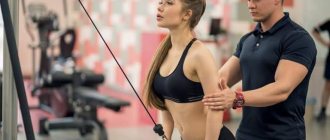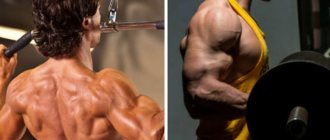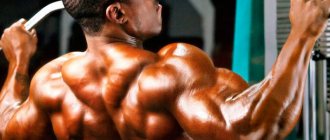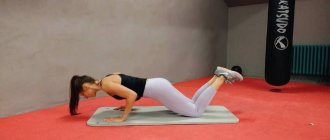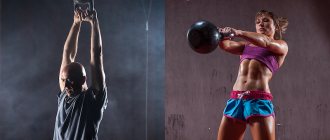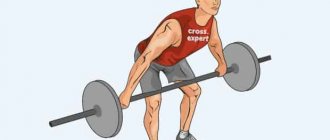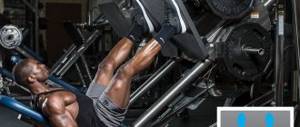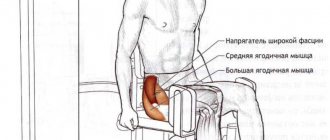Hello, friends! Today we will talk about strengthening the back muscles. A strong core of muscles around the spine plays an important role in maintaining correct posture and overall health. Therefore, the back muscles must be toned. In this article I will talk about an exercise called horizontal row in a block machine.
From the article you will learn the correct technique for performing horizontal rows and the main variations of the exercise. I will provide a detailed training program at home and in the gym, give useful tips and talk about the main mistakes encountered when performing the exercise. At the end of the article you will find a detailed video that clearly shows the correct execution technique.
What kind of exercise is this
The exercise is basic and is aimed at working the back muscles, which are second in size after the leg muscles. Therefore, when performing it, a large number of calories are expended and anabolic processes are launched. This allows you to use horizontal traction for both weight gain and weight loss.
Unlike a barbell, a horizontal block overloads the body less, since all movements are performed while sitting. Therefore, it is successfully used in fitness and bodybuilding.
The exercise is also often used by rowers in their training due to the similarity of the movements to rowing.
Block and traction machines[edit | edit code]
Block trainers
Block trainers
- These are special training machines that are found in almost any modern gym. There is an ambivalent attitude towards them; on the one hand, some say that they are needed and can be used, others say that in no case because there will be no mass. Almost every representative of the fair sex has a negative attitude towards free weights (dumbbells, plates) and equipment (bars, barbells), believing that such equipment is suitable only for men.
- Block frame
- Traction block on a cable
- Block leg trainer
- Leg adduction/adduction exercise machine
Block frame[edit | edit code]
Block exercise machine for legs (flexion/extension)
Exercises Performed
:
- overhead pull of the handle onto the triceps (handles – rope, iron, 1);
- traction of the handle from below to the biceps (handles – rope, iron, 2);
- leg abduction on a block (works the muscles of the inner/outer surface of the leg, 3).
Leg adduction/adduction exercise machine
Traction block on a cable (combined simulator)[edit | edit code]
Exercises Performed
:
- pulling the upper block to the chest/behind the head, with various grips (1);
- pull of the lower block to the belt (2).
Depending on the width of the grip and handle, it works the back muscles (latissimus) and biceps.
Block exercise machine for legs (flexion/extension)[edit | edit code]
Aimed at working out the muscles of the anterior (quadriceps) - when extending while sitting (1) and the back - when bending while lying down (2), the surface of the thighs.
Leg adduction/adduction exercise machine[edit | edit code]
To have a strong grip, and not only with your hands, this simulator is perfect for you, my beauties. It works great on the inner and outer thighs.
The benefits and harms of exercise
The back muscles maintain the correct shape of the spine and act as a counterweight to the chest muscles. If the back lags behind the chest in its development, stooping and accompanying problems appear.
The exercise is very effective for increasing the thickness and definition of the back muscles and helps to quickly build muscle mass without resorting to anabolic steroids. At the same time, posture correction occurs.
Lower block rows are less dangerous than barbell rows. The lower back is less stressed. Therefore, the exercise is great for people with weak lower backs, as well as for girls and women.
However, if performed incorrectly, damage to the spine, as well as elbow and shoulder joints, can occur.
Advantages of block exercise machines[edit | edit code]
Many blocks are much safer than exercises with free weights - and this is their main advantage, in addition, many block machines are much better than free weights for getting the feel of a specific exercise. But with all this, the block will grow muscle mass much worse, because it is a lightweight form in which the neuromuscular connection develops worse.
The use of block exercise machines is safer due to: the vector of movement and work of the stabilizer muscles. The freer the vector of movement of the projectile, the more dangerous the exercise. The risk of injury is reduced when the movement follows one vector, and stabilization along one vector occurs in a block simulator.
When we work with free weights, we work strictly in a vertical vector, the advantage of blocks is that we can change the angle. We can, under some conditions, make the load horizontal, we can make it whatever we want. How does this manifest itself in practice? Example: bent over barbell row, when you are bent over and pulling the barbell is not comfortable for you, because in addition to the back, stabilization is achieved by working the pelvis, legs, hamstrings, and biceps on the arms.
Correct technique and exercise variations
There are several types of horizontal rods, slightly different from each other in the technique of execution.
Craving to the waist (or to the stomach)
This is a standard version of the exercise.
- Sit on the machine. Place your feet on the special platform, bend your knees slightly and lock your legs throughout the approach. The bend angle must be selected in such a way that the knees do not interfere with the movement of the arms, and the deflection in the lower back remains constant.
- Leaning forward, take the handle of the block and take the starting position when the torso is in a vertical position and the load is raised above the stops. The chest is straightened, and the arms are slightly bent at the elbows.
- Holding your breath, pull the handle towards your waist or stomach. The movement is accomplished by the muscles of the back with the scapulae moving together. The elbows move straight back, as far as possible.
- As you exhale, slowly return to the starting position.
When performing the exercise, the deviation of the body from the vertical position should not exceed 10 degrees in each direction. Don't help yourself pull the load by arching your lower back.
Through the sides
This option pumps up the delta muscle bundles well.
- Install the D-shaped handle. You will also need an incline bench installed in front of the machine.
- Sit on a bench. The chest rests on the back of the bench. The arm is slightly bent at the elbow, and the hand is at shoulder level.
- As you exhale, pull the handle back and to the side, describing a wide arc in the air.
- As you inhale, return to the starting position.
Rowing
If you have access to a rowing machine, you can perform rowing rows. The muscles of the abs, arms and legs additionally work here.
- The back should be straight and slightly tilted forward. The feet fit tightly to the pedals.
- Bend your knees and straighten your arms to grasp the handle. The body tilt forward is no more than 30 degrees.
- Then begin to push off the pedals using the strength of your legs. The torso takes a vertical position.
- When the angle of your knees becomes 90 degrees, begin to tilt your torso back and bend your elbows at the same time. The elbows move straight back.
- In the final phase, the body is tilted back 25 degrees, and the handle is pulled towards the stomach and touches the lower ribs.
- Then smoothly return to the starting position.
Example workout
The training should begin with a warm-up: jumping and running in place, warming up the shoulder and elbow joints and spine. 10-15 minutes will be enough.
Horizontal rows should be used as the final exercise on the day of back training in order to finally load the muscles. It’s better to start with more energy-intensive exercises: pull-ups and barbell rows.
At home
At home, the exercise machine can be replaced with an expander, but you need to think about where to attach it (door, sofa leg, wall bars, etc.). If there is no horizontal bar in your apartment, you can do pull-ups outside, on the nearest sports ground.
The back workout will consist of the following exercises:
- Pull-ups on the horizontal bar - 3 sets to the maximum.
- Bent-over dumbbell rows – 3 x 12 repetitions.
- Vertical expander row - 4 sets of 15-18 repetitions.
- Horizontal expander row - 4 x 15-18 repetitions.
In the gym
It would be good to use a barbell in the gym.
- Perform 3-4 sets of maximum pull-ups.
- Deadlift with a barbell – 3 to 9-12.
- Rows on the upper block - 3 sets of 15 repetitions.
- Horizontal row – 3 x 15 reps.
You can replace the traction on the block with a lever traction on the Hammer simulator. It relieves stress from the spine and allows you to better work your back, as you can increase the working weight.
At the end of your workout, be sure to stretch your back muscles. To do this, you can sit on the floor, straighten your legs and clasp your feet with your hands. Sit in this position for 30-45 seconds. Repeat this 3-4 times. You can also hang on the bar for 30 seconds.
A set of exercises on the upper and lower blocks
The pulley device allows you to perform movements from different angles. The handle of the block can be pulled from top to bottom, from bottom to top, towards you, to the side, or diagonally. Thanks to this, the muscles are worked out in as many different ways as possible. If you plan to use the upper or lower block in mass training, you need to start by mastering the following exercises:
- Pulling the block to the belt. Performed in a sitting position. The seated athlete holds the handle of the block with both hands and pulls it towards himself. The handle moves in a horizontal plane. The exercise is multi-joint. It involves the work of several muscle groups at the same time, which makes it possible to work with fairly large weights. The main load here falls on the back muscles. It is better to perform block rows towards the waist towards the end of the session after deadlifts and bent-over barbell rows. You can grasp the handle of the exercise machine in different ways: with a straight and reverse grip, narrow and wide. Alternatively, you can work with one hand: this will increase the range of motion.
- Upper chest pull. The exercise uses an overhead block. The work is done while sitting. The muscles of the back and shoulder girdle receive the load. Different handles and different grip types can be used. The handle is pulled to the chest, moving from top to bottom. Lat rows can be performed after a set of exercises with free weights or used to warm up the muscles of the shoulder girdle at the beginning of a workout.
- Lower pull to the chin. The exercise focuses on the middle bundle of the deltoid muscle. The effect is enhanced if you place your hands wide. In delt training, this exercise should come after overhead presses, but before delt exercises that only work one joint.
- Lower pull between the legs. The exercise is similar to the Romanian deadlift. Performed while standing with your back to the block device. The athlete bends over with his arms extended between his legs. Then he straightens up, moving the handle forward and pulling the cable with force. This way you can strengthen your hips, buttocks and lower back. The exercise is performed after squats and hyperextension.
Tips for implementation
Sets and reps
With a working weight, it is enough to perform 3 approaches. Additionally, you need to do 1-2 warm-up approaches with a weight 1.5-2 times less than the working one.
Choose the number of repetitions depending on the purpose of your training. If you need muscle growth, do 6-10 repetitions. For endurance training, as well as for beginners, I recommend performing 12-15 repetitions, and if there is a lot of “fat”, then all 18.
How to choose weight
Choose a weight with which you can do the required number of repetitions per set. No more and no less. For example, for 12 repetitions, the load should be such that the 11th and 12th repetitions are performed with all your might.
Equipment
If you have a weak lower back, use a protective belt.
Fitness gloves will also be useful to protect your hands from calluses during training. This is especially true for the weaker sex.
Shoes should have grippy soles to prevent your feet from slipping off the support platform of the machine.
General recommendations[edit | edit code]
Who is suitable for exercises on block machines?
- athletes on drying, because they are safer and this will help avoid injury and work in different angles.
- bodybuilders on mass, but it is better to do exercises with free weights, and then only move on to exercises on a block machine. Moreover, the more experience an athlete has, the more block exercise machines he can include in his training.
- It is not advisable for beginner athletes to include block exercise machines in their training, because they do not yet have developed muscle sense for this.
- girls, because They don’t have a goal of large muscle mass, their goal is safer training. Therefore, block simulators are ideal for this task.
